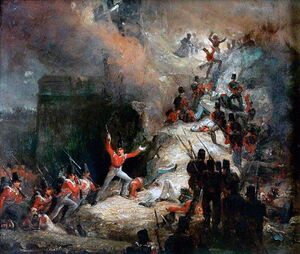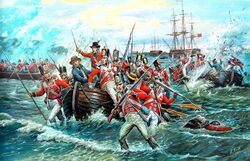Battle of Delhia
The Battle of Delhia (12 November - 21 December 1822) was an engagement between the Coalition forces led by General Sir. Benedict Humeray against the Sikh and Aurucolian Forces under Marshal Flórián Székely de Kisbátor. The battle of Delhia would ultimately be one of the bloodiest battles in the war, as well as one of the best examples in which marine forces were used extensively, as well as one of the earliest examples of amphibious landings.
Since May, Humeray had already been planning the taking of Delhia, which was perceived by many as the capital city of Aurucolian Indiae, and as well as the key objective of isolating the Ganges Region from the rest of Indiae. With the victory at the Battle of Gwailor, the Lucians destroyed one of the last bridges near the Ganges River, as well as setting up roadblocks and blocking various routes, preventing any relief or supplies in getting to the defenders still at the Ganges region. The last bridge was in Delhia, where Kisbátor had set up extensive defences. By the time the battle came, Humeray began his attack but was repulsed. Then, a Lucio-Galbadian force marched north towards Red Fort, which was lightly defended by Aurucolian riflemen. But the defenders would be overwhelmed and Red Fort was taken, effectively surrounding Delhia, except for the bridge on the east that led to the Ganges region. Despite this, the Aurucolians and Sikhs maintained a strong defence of the city. By 1 December, the Coalition forces were still unable to take Delhia nor scale the walls of the city.
Then, Humeray shifted his strategy of taking the town by landing marine troops by the banks of the Ganges River and into Delhia. Luckily for Humeray, he had prepared for this strategy since May in the case that his forces would be unable to scale the walls. The Royal Navy managed to sail small ships through the Ganges River and these ships would arrive in time by early December. Among the personnel that sailed were the elite Royal Marines , specialising in rapid movements and attacks from the water. Humeray would boost the force up with elite Nihhonese, Nibelheimian, and Baselian troops. Galbadian General Georg Ludwig Koppel also would contribute to the Marine force. By 10 December, Humeray resumed his attack and attempts on taking the city. Meanwhile, an Aurucolian relief force attempted to relieve the city at the Battle of Red Fort, which was prevented by Galbadian General Levi Erlach. This would effectively end any form of relief force to enter into the town. By 19 December, Humeray assigned General Johannes Vandemeer to command the marine force. By 20 December, Royal Navy ships began to bombard the city as the marine force began to row towards the bank of the river. By 1pm, the Marine force and some 27 boats docked on the bank and many troops unloaded and they slowly began to fight their way to the pier. This marked the first Coalition forces inside Delhia. This would render Kisbátor to send in a part of the defenders to prevent the Marines from getting inside further into the city. This gave Humeray the signal to storm the wall. By 7pm, the Coalition forces stormed the city walls while ignoring musket fire. Slowly, the Aurucolians and the Sikhs in the city would be outnumbered, as many attempted to cross the river and into the safety of the Ganges Region. By 11pm, the Marine Forces had managed to capture the bridge at Delhia, effectively closing the last bridge and completing the encirclement of the Aurucolians and Sikhs still in the Ganges Region. Hostilities would continue until the dawn of 21 December.
The loss of Delhia gave a heavy blow to the Sikhs and Aurucolians, as the Sikh and Aurucolian-controlled regions were now split in two. Kisbátor was forced to retreat to Jaipur while the Sikhs and Aurucolians that were trapped in the Ganges Region would not surrender until the Battle of Kandia. The action would prove to be one of the largest encirclements of the war.

